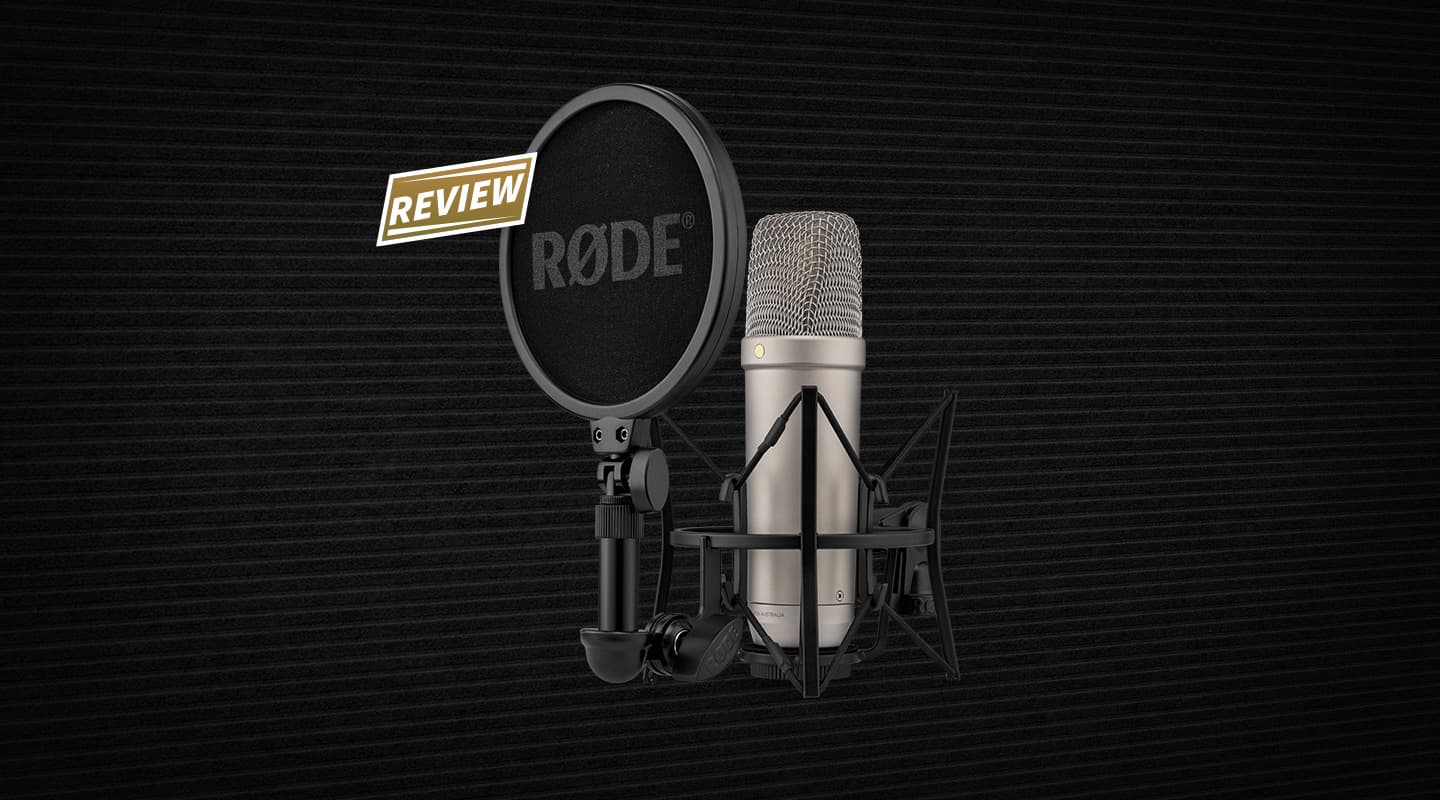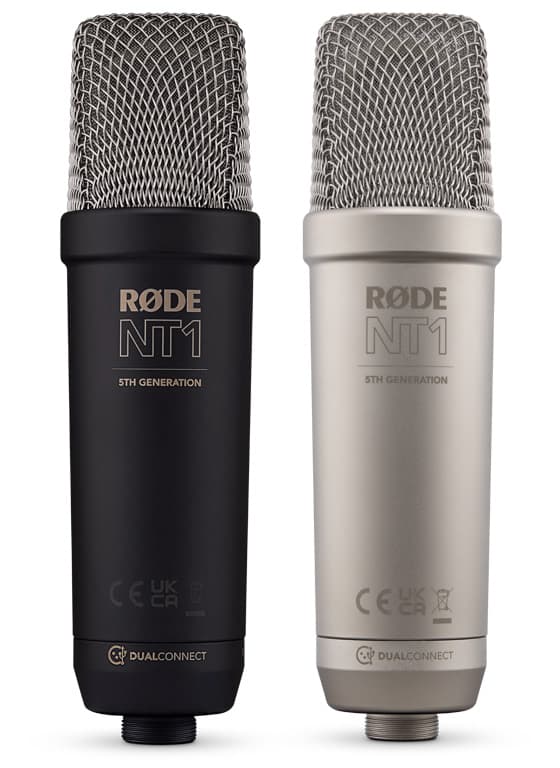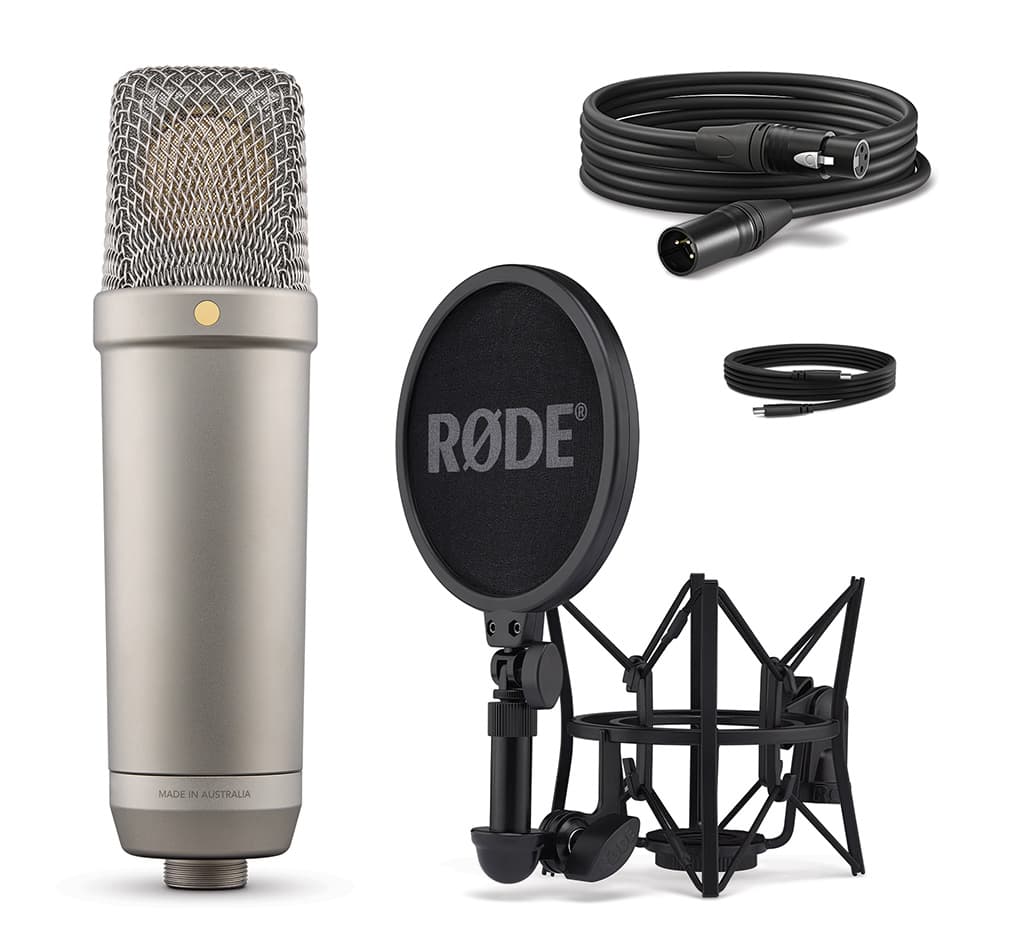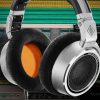
Review: RØDE Microphones NT1 5th Generation
It’s a studio condenser. It’s a USB mic. It’s the latest generation of the Rode NT1.
Back in 1991 the release of the Rode NT1 was a game changer. For smaller backyard studio owners and impoverished musicians making home recordings on a budget the fixed cardioid NT1 condenser was an absolute godsend. It was affordable, sounded better than anything else on the market within cooee of its price point and allowed home recordists all over the world to up their game. The ‘little Aussie company that could’ suddenly had sales going through the roof and, along with the introduction of affordable digital recording interfaces and the DAW revolution, the NT1 really helped usher in the age of the ‘project studio’. The first NT1 came from very humble beginnings (read Rode founder, Peter Freedman’s, recollections here — sourced from China, then modded in a back room in Rode’s Sydney office but the mic’s phenomenal success (along with the subsequent NT2) allowed Rode to build its state-of-the-art manufacturing facilities in Sydney and enjoy sustained global success.
BLACK BELT
The NT1 has seen a few subsequent upgrades, the principal one being the NT1A, with its superior specs, build quality and quality control that also went on to be a major international best-seller. In the years since, Rode has continued to develop and release innovative cutting-edge microphone models to suit a wide variety of applications and it was probably only a matter of time before they returned to the mic that started it all and give it a new lease on life. The result of that process is the 5th Generation NT1, still recognisably the same mic but with a whole bunch of new tricks under its belt.
First and foremost, the mic has been redesigned from the ground up, meaning lower self noise (a whisper quiet 4dBA), wider dynamic range, and an internally shockmounted one-inch HF6 gold-sputtered capsule manufactured to sub-micron tolerances. It can handle just about anything you can throw at it (up to 142dB SPL) and has a broad quoted frequency response of 20Hz–20kHz.
The voicing of the mic has changed a little too (more on that later), and there is even a redesigned cradle mount, but the real point of difference to previous iterations of the mic are the digital add-ons.
Rode has a patent application pending for the world’s first hybrid XLR/USB connector, utilised here to allow for both traditional XLR output and (via the built-in ‘Revolution’ preamp and converter) a USB output straight into a computer or other compatible digital device. Recording directly via the USB connection allows for 32-bit floating point recordings at up to 192k conversion rates, meaning an enormous dynamic range is available. Rode says that this approach ‘can effortlessly capture everything from a whisper to an explosion with no chance of distortion or clipping and no need to set complex gain controls.’

NEED TO KNOW
RØDE Microphones NT1 5th Generation
Studio Condenser Microphone
TICKING ALL BOXES
Unpacking the large 5th Generation NT1 box is quite a journey of discovery. Inside are a number of smaller boxes containing a redesigned shockmount, pop screen, digital and analogue cables, dust cover, and finally the mic itself. Everything is beautifully packaged in white cardboard and carefully laid out, the lack of a supplied flight case perhaps the only obvious concession to the mic’s budget price point. Apart from the matte black finish (silver is also available if you so desire), the new NT1 is essentially visually unchanged from the older NT1A. The body is the same size, the signature Rode gold dot still indicates which side to sing into, the silver mesh grille even has the same patterning. The old and new mics are more or less the same weight, remarkable given the new mic houses a preamp and digital converter. The USB connection is cleverly housed alongside the three XLR pins and the overall socket housing is a standard size, making the new technology very discrete indeed.
The new shockmount has a clever adjustable pop screen holder fixed to the front of it. The supplied pop screen easily screws into the holder and can telescope upwards if desired. This is a great feature for vocal recording but I would have preferred it if this whole extra housing could be detached from the shockmount when recording other sources as it does protrude outwards a little. This minor gripe aside, the whole package is beautifully manufactured, looks great and is astonishingly good value at street price of around A$399.
MAINTAINING TRADITION
Before testing out the digital side of things, I wanted to give the NT1 5th Generation a good work out in traditional XLR mode, and I gave it a multitude of studio tasks on a variety of projects. Its first gig was on female backing vocals by the wonderful Janie Gordon, then onto strings and percussion for the upcoming Harry Hookey album. Switching from a solid-state preamp to a valve one, I followed up by distance-miking some guitar amps, then came back in closer on double bass, acoustic guitar and banjo. The mic did great work capturing and presenting the sounds on all these tasks and I never felt the need to reach for one of my much more expensive condensers. The female vocals were smooth and sweet, the double bass rich and mellow, the banjo detailed and well balanced.
Finally, I tested its layering credentials alongside an older NT1A. I had the two mics as close together as possible through two matched channels of a Universal Audio 2108 and tracked multiple acoustic guitars, drum overheads, double bass and male vocals. By grouping the two mics’ tracks separately I could easily switch between the two sounds over the whole composition, giving me a really good sense of the similarities and differences to be heard between them. Here are my thoughts:
the new mic’s sounds take a step forward and present an image with more depth and dimensionality

GUTS & GLORY
Back in the ’90s I was one of those aforementioned ‘impoverished musicians’ and owned an original NT1 for quite a few years. I really liked it as an all-round studio tool and I’ve subsequently used quite a few NT1As on various projects. I’m well acquainted with the sound of these mics and it was a real pleasure to delve back into the NT1 world again.
It was quickly apparent that the new NT1 is a worthy heir to the earlier versions, and while some of the sonic signature of the old model remains, this new version presents sounds in a more sophisticated way.
Most notable to me was a subtle but discernible increase in the lower midrange and bottom end. The signature top-end sheen and clarity bump is still there (as borne out by the 3-4dB rise at around 11kHz on the frequency response graph) but it is now more evenly matched by the lower frequencies and feels more balanced and ‘true’ as a result.
Toggling between the previous-generation NT1A and the new NT1 recordings I could hear a lot of similarities in the top end but the fundamentals and midrange guts of the new mic’s sounds take a step forward and present an image with more depth and dimensionality. The differences were not day and night but they were there, and I think Rode has done an admirable job, striking the right balance between familiarity and enhancement with the voicing of this microphone. The new NT1 is a fairly sensitive microphone: -32dB re 1V/Pascal (25mV @ 94dB SPL) ±2dB @ 1kHz, but handles louder sources with no trouble at all. Overall, the revamped NT1 delivers all the versatility and ease of use of the original while noticeably upping the ante in terms of its sonics.
REVOLUTION WILL BE PODCASTED
Having had my trip down memory lane I decided it was time to investigate the future. Setting up the NT1 5th Generation for USB recording was a fairly simple process. Rode’s step-by-step guide is very helpful (in my case for the Pro Tools platform but almost all platforms are supported). It took me about five minutes to create a new aggregate device and get a 48kHz, 32-bit floating session up and running with the mic plugged directly into the back of my iMac via the long, supplied USB cable.
Sample rates up to 192k are achievable but Rode recommends 48k for laptops. The simplicity and portability of this configuration lends itself to podcasts and quick location recording tasks where a laptop would be the weapon of choice, so I wanted to hear the quality at that resolution.
At 32-bit/48k the sound quality of the built-in Revolution preamp and A/D converter is clean and musical, with my Martin guitar coming back richly detailed with all its sonic complexity intact.
The digital sound doesn’t perhaps have quite the same euphonic sheen as when using expensive external preamps, but the tonal balance and the detailed presentation are all there and the fidelity at the higher resolutions is excellent.
In what is quite a significant innovation, you can track without worrying too much (or at all, really) about gain settings. If a track recorded via USB at 32-bit floating point is playing back with clipping, a simple normalisation render will rein the overall level in and the clipping will disappear. This is due to the very high dynamic range offered by the analogue-digital converters on-board the NT1 5th Generation, so the clipping is only present at playback, not embedded in the recorded audio. If a track is recorded too quietly, simply normalise it and it will play back louder without any appreciable lifting of the noise floor. It’s like magic!
Most significantly, you can grab an NT1 and your laptop and go just about anywhere to make great sounding recordings. Goodbye external interfaces. Goodby power supply and connection issues. Goodbye fretting about gain settings, noise floors and clipping. On-the-go recordists and podcasters can henceforth concentrate on their subjects, getting their recordings down and worry about level adjustments in post later on. Expect a great deal less digital clipping from your favourite low-budget podcasters very soon!
FIRST PAST THE POST
Speaking of post production there is a wealth of other back-end value-adding that Rode is offering as part of the NT1 5th Generation package. Firstly, there’s a suite of processing tools from Aphex, a brand owned by Rode, including compressor, noise gate, two-step high pass filter, Aural Exciter and Big Bottom effects. These processing tools as well as setups for configuring and saving the mic’s gain settings and downloading firmware updates are available via Rode’s two companion software programs: Rode Central and Rode Connect. Using the latter, up to four NT1s can be connected via USB to a single computer, but up to eight can be connected using the aggregate device function on Mac, or Rode’s custom ASIO driver on Windows. Buyers can also download Rode’s Unify software, a simple high-grade platform for streaming, mixing tracks, routing and creating separate monitor mixes.
STICKING UP FOR THE LITTLE GUY
Rode’s ethos has always included empowering the budget conscious. In more recent times it has also brought some incredibly well-made, innovative and user-friendly technology to market that challenges and enhances the way audio tasks are done. With the release of the 5th Generation NT1, Rode combines these two spheres of influence, delivering a great sounding mic that borrows from the past and steps boldly into the future. Frankly, if I had tested this microphone in just its XLR capacity, blindfolded, with no knowledge of brand or antecedence, I would have comfortably placed it at a price point somewhere around twice what Rode are asking for. The fact the new NT1 comes cleverly packaged with so many additional digital features and capabilities makes it a knock-out deal. If you’re looking for an affordable workhorse condenser that can also lighten your load when on location and keep on giving with bundled digital add-ons, the NT1 5th Generation ticks all the right boxes. Best of all it’s a great-sounding, cutting-edge piece of kit made to extremely high standards, here in Sydney, and comes with a 10-year warranty.



























Hey this mic sounds great 🙂